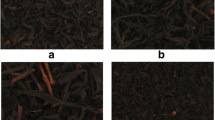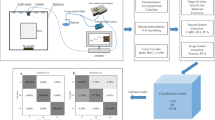Abstract
The world’s high-value crop is tea, its aspect plays a powerful role in its marketability. Tea is the utmost extensively absorbed aromatic beverage with the legion of health benefit and respond as a remedy for various disease like neurological disorder and cardiovascular. The identification of tea fermentation is onerous due to the heavy production of products. The manual investigation is expensive, laborious, and inconsistent. Thus, an automated machine learning-based algorithm is proposed for the grading of tea fermentation (fermented, over-fermented, under-fermented). Firstly, images are pre-processed by Gaussian filtering to enhance the quality of the image and removing of noise. Then various features namely, statistical, textural, color, geometrical, laws texture energy, the histogram of gradients, and discrete wavelet transform are extracted (150) and selected from feature vector by PCA. Lastly, k-NN, SRC, and SVM are used to make decisions for the detection of tea fermentation levels. The performance of the system has been validated by the k (10) fold cross-validation technique. The proposed algorithm achieves 87.39% (k-NN), 89.72% (SRC), and 98.75% (SVM) for tea fermentation level detection. The proper feature selection shows the enhanced performance of the system. Among three different classifiers, SVM shows more efficient results that are promising and comparable with the literature. This paper also includes the analytical comparison of distinct approaches proposed by the different researchers for tea fermentation level detection. This potential fermentation level detection may guide the detection of tea products which further promotes the development of the food industry.







Similar content being viewed by others

References
Bakhshipour A, Zareiforoush H, Bagheri I (2020) Application of decision trees and fuzzy inference system for quality classification and modeling of black and green tea based on visual features. Food Meas 14:1402–1416. https://doi.org/10.1007/s11694-020-00390-8
Bhargava A, Bansal A (2018) “Fruits and vegetables quality evaluation using computer vision: A review” J King Saud Univ Comput Inf Sci (Elsevier, Scopus Indexed)
Bhargava A, Bansal A (2020) Quality evaluation of Mono & bi-Colored Apples with computer vision and multispectral imaging. Multimed Tools Appl 79:7857–7874
Bhargava A, Bansal A (2020) Machine learning-based quality evaluation of mono-colored apples. Multimed Tools Appl 79:22989–23006
Bhargava A, Bansal A (2020) Automatic detection and grading of multiple fruits by machine learning. Food Anal Methods 13:751–761
Bhargava, A, Bansal, A (2021) “Classification and grading of multiple variety of apple fruit”, Food Anal Methods, https://doi.org/10.1007/s12161-021-01970-0.
Bhargava, A, Bansal, A (2021) “Classification and grading of multiple variety of apple fruit”, Food Anal Methods, https://doi.org/10.1007/s12161-021-01970-0
Borah EL, Hines M, Bhuyan (2007) Wavelet transform based image texture analysis for size estimation applied to the sorting of tea granules. J Food Eng 79(2):629–639, ISSN 0260-8774. https://doi.org/10.1016/j.jfoodeng.2006.02.022
Chang, CC, Lin, CJ (2001) Libsvm: A Library for Support Vector Machines, via http://www.csie.ntu.edu.tw/cjlin/libsvm. Accessed 4 Feb 2021
Cheng G, Xie X, Han J, Guo L, Xia G-S (2020) Remote sensing image scene classification meets deep learning: challenges, methods, benchmarks, and opportunities. IEEE Journal of Selected Topics in Applied Earth Observations and Remote Sensing 13:3735–3756
Cheng G, Yang C, Yao X, Guo X, Han J (2018) When deep learning meets metric learning: remote sensing image scene classification via learning discriminative CNNs. IEEE Trans Geo Sci Remote Sens 56(5):2811–2821
Dorj UO, Lee M, Yum S (2017) An yield estimation in citrus orchards via fruit detection and counting using image processing. Comput Electron Agric 140:103–112
Guangxin R, Gan N, Song Y, Ning J, Zhang Z (2021) Evaluating congou black tea quality using a lab-made computer vision system coupled with morphological features and chemometrics. Microchem J 160(Part A):105600, ISSN 0026-265X. https://doi.org/10.1016/j.microc.2020.105600
Hall JG, Rapanotti LL (2013) Beauty inSoftware engineering. Computer 46:85–87 https://engineering.purdue.edu/RVL/Database/IFW/database/index.html. Accessed 6 Feb 2021
https://www.downtoearth.org.in/news/agriculture/agri-share-in-gdp-hit-20-after-17-years-economic-survey75271#:~:text=The%20share%20of%20agriculture%20in%20GDP%20increased%20to%2019.9%20per,per%20cent%20in%202019%2D20 (2020) Assessed on 1 March 2020
India at a glance. FAO in India. Food and Agriculture Organization of the United Nations (2018). Link: <http://www.fao.org/india/fao-in-india/india-at-a-glance/en/>. Accessed 24 Jan 2021
Jolliffe I (1986) Principal component analysis. R.R. Donnelley & Sons, Harrisonburg
Karak T, Bhagat RM (2010) Trace elements in tea leaves, made tea and tea infusion: A review. Food Res Int 43:2234–2252
Kimutai G (2021) https://doi.org/10.17632/cbpf92vr5j.1, Assessed on 2 June 2021
Kimutai G, Ngenzi A, Ngoga SR, Ramkat RC, Förster A (2021) An internet of things (IoT)-based optimum tea fermentation detection model using convolutional neural networks (CNNs) and majority voting techniques. J Sens Sens Syst 10:153–162. https://doi.org/10.5194/jsss-10-153-2021
Liuwei M, Chen X, Chen X, Yuan L, Shi W, Cai Q, Huang G (2020) Linear and nonlinear classification models for tea grade identification based on the elemental profile. Microchem J 153:104512, ISSN 0026-265X. https://doi.org/10.1016/j.microc.2019.104512
Mamta S, Hemanga B, Bhawna T, Sweta J, Moreshwar K, Ranbir S, Pankaj G (n.d.) Horticultural statistics at a glance. Link: <http://nhb.gov.in/statistics/Publication/Horticulture%20At%20a%20Glance%202017%20for%20net%20uplod%20(2).pdf>. Accessed 25 Feb 2021
Moallem P, Serajoddin A, Pourghassem H (2017) Computer vision based apple grading for golden delicious apples based on surface features. Inf Process Agric 4:33–40
Ou X, Pan W, Xiao P (2014) Vivo skin capacitive imaging analysis by using grey level co-occurrence matrix (GLCM). Int J Pharm 460(2):28–32
The economic times. GDP data; 2018 (2018) Link <https://economictimes.indiatimes.com/news/economy/indicators/view-being-the-worlds-6th-largest-economy-means-littlefor-indias-future/articleshow/64966415.cms>. Accessed 16 Mar 2021
Wen X, Fang J, Diao M, Zhang C (2012) Artificial neural network modeling of dissolved oxygen in the Heihe River. Northwestern Chin Environ Monit Assess 185(5):4361–4371
Wright J, Yang AY, Ganesh A, Sastry SS, Yi M (2009) Robust face recognition via sparse representation. Pattern Anal Mach Intell IEEE Trans 31:210–227
Zhou X, Tang Z, Qi F (2018) Identification of black tea fermentation degree based on convolutional neural network, Int Conf Intell Auton Syst (ICoIAS), https://doi.org/10.1109/ICoIAS.2018.8494051
Author information
Authors and Affiliations
Corresponding author
Additional information
Publisher’s note
Springer Nature remains neutral with regard to jurisdictional claims in published maps and institutional affiliations.
Rights and permissions
Springer Nature or its licensor (e.g. a society or other partner) holds exclusive rights to this article under a publishing agreement with the author(s) or other rightsholder(s); author self-archiving of the accepted manuscript version of this article is solely governed by the terms of such publishing agreement and applicable law.
About this article
Cite this article
Bhargava, A., Bansal, A., Goyal, V. et al. Machine learning & computer vision-based optimum black tea fermentation detection. Multimed Tools Appl 82, 43335–43347 (2023). https://doi.org/10.1007/s11042-023-15453-3
Received:
Revised:
Accepted:
Published:
Issue Date:
DOI: https://doi.org/10.1007/s11042-023-15453-3



